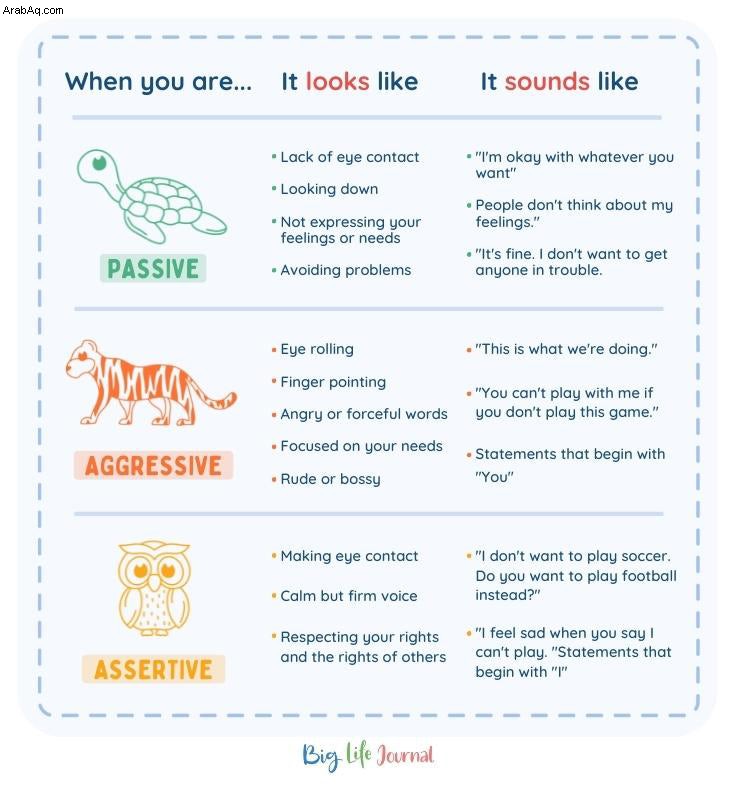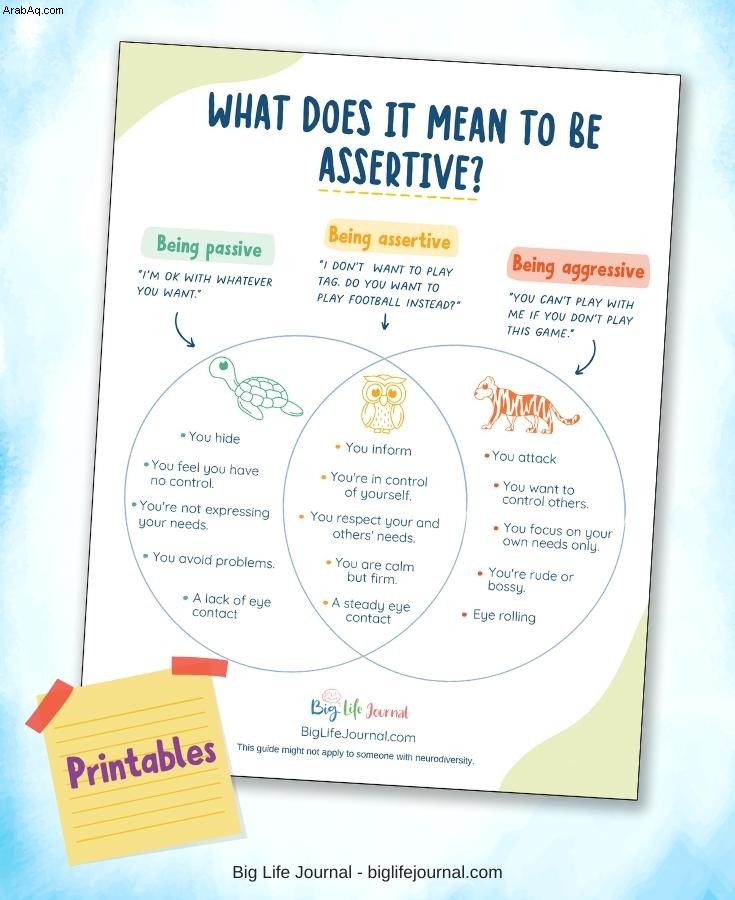إذا كنت ترغب في تربية أطفال أقوياء وواثقين من أنفسهم ، فعليك تعليم الحزم هو المفتاح. يعرف الأطفال الحازمون كيفية الدفاع عن أنفسهم (والآخرين) دون إيذاء أو لفظ. يمكنهم قول "لا" ، والتواصل بوضوح ، والحفاظ على العلاقات الإيجابية التي تتوافق مع الخاصة بهم بالإضافة إلى احتياجات الآخرين.
قليل منا ولد حازمًا ، والخوف من الظهور بمظهر وقح أو أناني يمكن أن يمنعنا من الدفاع عن أنفسنا. لحسن الحظ ، مع الممارسة ، يمكننا مساعدة الأطفال على إتقان هذا القوة القدرة ، واكتساب الفوائد العديدة المرتبطة بالتواصل الحازم.
من خلال الممارسة ، يمكننا مساعدة الأطفال على إتقان هذه القدرة القوية ، واكتساب الفوائد العديدة المرتبطة بالاتصال الحازم.

قبل المتابعة ، اعتقدنا أنك قد ترغب في تنزيل موقعنا المجاني ماذا يعني أن تكون حازمًا للطباعة! إذا أردنا تربية أطفال أقوياء وواثقين من أنفسهم ، فإن تعليم الحزم هو المفتاح! يعرف الأطفال الحازمون كيفية الدفاع عن أنفسهم (والآخرين) دون إيذاء أو لفظ.
1. تحدث عنها
أخبر الأطفال أن هناك 3 أساليب أساسية للتواصل. في كل مرة نتحدث أو نتفاعل مع أشخاص آخرين ، نختار إحدى الطرق التالية: المبني للمجهول ، عدواني ، أو حازمًا .
يمكننا معرفة أسلوب الاتصال لدينا من خلال البحث عن أدلة في أقوالنا وأفعالنا:
 للأطفال الصغار ، حاول استخدام الحيوانات لتمثيل كل نمط. اسمح لهم بالعصف الذهني لمخلوقات مختلفة مرتبطة بالأنواع الثلاثة: سلبي (سلحفاة في قوقعته أو فأر يجري ويختبئ) ، عدواني (نمر يهاجم أو دب يزأر) و حازم (بومة حكيمة أو كلب عائلي هادئ ينبح في خطر).
للأطفال الصغار ، حاول استخدام الحيوانات لتمثيل كل نمط. اسمح لهم بالعصف الذهني لمخلوقات مختلفة مرتبطة بالأنواع الثلاثة: سلبي (سلحفاة في قوقعته أو فأر يجري ويختبئ) ، عدواني (نمر يهاجم أو دب يزأر) و حازم (بومة حكيمة أو كلب عائلي هادئ ينبح في خطر). أيضا:
- امدح الأطفال لاستخدامهم أسلوب تواصلهم الحازم أو "البومة" عند التعامل مع موقف صعب ("أحب الطريقة التي تحدثت بها!")
- اقرأ "الفأر والوحش وأنا:تأكيد الذات للشباب" بقلم بات بالمر
- أشر إلى السلوك السلبي والعدواني والحازم في أفلامهم وبرامجهم التلفزيونية المفضلة (الضابط جودي هوبس في Zootopia أو فروزن آنا هي أمثلة رائعة على الإصرار). لاحظ كيف تتفاعل الشخصيات من حولهم مع كل نوع
أخيرًا ، فكر في الاتصال باعتباره طيفًا ، مع السلبية في أحد طرفيه والعدوان في الطرف الآخر - الحزم هو "النقطة الحلوة" بينهما. ذكِّر الأطفال أنه بغض النظر عن النمط الذي يستخدمونه حاليًا أكثر من غيرهم ، يمكنهم التعلم لتكون حازما!
2. تحديد الحدود
ناقش كيف توجد حدود في العالم ، أو الخطوط التي لا ينبغي تجاوزها. هذه موجودة على المادي المستوى ، مثل علامات التوقف أو حتى "الفقاعات الشخصية" (المساحة المحيطة بأجسادنا) وكذلك العاطفي الحدود (الأشياء التي تؤذي مشاعرنا).
تتمثل إحدى طرق احترام هذه الحدود في مناقشة قوة "لا". سواء كان ذلك عناقًا غير مرغوب فيه من الجدة أو صديقًا متسلطًا في الملعب ، يحتاج الأطفال لسماع ذلك يقول بحزم لا is not only acceptable--it’s their right.
Consider these ideas:
- Explain that setting boundaries (saying “no,” “stop” or “I don’t like that”) keeps our bodies and minds safe and healthy
- Support kids in saying “no” over negotiable issues (not wanting to wear certain clothing, hug someone or read a particular book are good places to start)
- Read “Listening to My Body” by Gabi Garcia to stay connected to the important sensations and emotional cues our bodies send us
The Big Life Journal 2nd Edition (ages 7-10) is a great starting point to help children develop strong Social-Emotional Learning (SEL) and growth mindset مهارات. Through inspiring stories, colorful illustrations, and engaging guided activities, your child can discover how to believe in themselves, how to face challenges with confidence, and more!
Assertive communication means considering the needs of others, but never at our own expense. I often say to my daughter, “If it’s not kind to you , then it’s not kind at all . "
3. Teach “I” Messages
Of all the conflict resolution strategies that exist, the “I” message is my all-time favorite. It’s easy to use and resolves problems like no other.
Here’s the simple formula:“I feel ( insert feeling ) when you ( insert behavior ). I would like you to ( insert request ) .”
When my daughter experienced a situation at the playground (other girls said she couldn’t play with them), we practiced my suggestion:
“I feel angry when you tell me I can’t play . I would like you to let me join in .
Then my daughter came up with her own:
“I feel hurt when you leave me out . I’d like you to stop saying I can’t play .”
Know that “I” messages work because they are non-judgmental . They neither blame nor criticize and keep the listener from feeling attacked or defensive.
You might also try:
- Practicing similar assertive phrases:”I need more space”/”I don’t like it when…,”/”I think…”
- Using a mirror to practice (check for eye contact and confident posture)
- Sharing the positive impact of “I” messages:“I loved how you used that ‘I’ message to tell me what you wanted. It made me feel like I wanted to help you.”
If you need some tips on how to encourage your child to be assertive, don't forget to download the FREE What Does It Mean to Be Assertive? printable today!

4. Build Friendship Skills
Assertiveness skills are not just necessary for dealing with the playground bully. It’s often our closest friendships that require making our needs and feelings known.
Start by talking with your child about the qualities she wants in a friend. What kinds of things make a good friend ؟ How do friends act ؟
Share the characteristics YOU look for, and be sure to say that you work hard to be the kind of friend you want.
Next, discuss how friendship conflicts are normal sometimes and are actually opportunities to grow your assertiveness skills . Identify some common sources of disagreement, and make a list together. This might include:
- Not enjoying the same activities at recess
- Feeling left out when your friend plays or talks to someone else
- A friend who brags frequently
- Being excluded from a birthday party
Try to identify 1-2 solutions for each of these scenarios, and role-play how to handle them (using an ‘I’ message is a great start). While a “perfect friendship” does not exist, all relationships benefit from the openness and honesty that assertiveness allows.
5. Model Confidence
We know that kids watch what we do more than what we say . If we hope to raise confident kids, it’s crucial to communicate assertively in our own الأرواح. Not always the easiest thing!
You might start by:
- Speaking up when you need to, and letting your child see you say (and stick to) “no”
- Discussing how assertiveness is difficult for you, and how you overcome it by practicing
- Using a calm, confident voice when stating your views
- Praise (and even reward) yourself when you do well
Another way to model assertiveness is through active listening . During a conflict, simply restate what the other person has said before you respond. This is especially impactful when the disagreement is with your child:“You’re saying ‘no’ to the blue dress today. I hear you” or “You really want to watch the fireworks. It seems like the other kids all get to stay up late.”
Assertiveness takes practice for all of us . But modeling assertive communication allows both us and our kiddos to reap its powerful benefits, including confidence, high self-esteem, and positive relationships.
If you're looking for additional resources to support your child's journey, check out our How to Transform Your Child’s Negative Self-Talk Into Self-Love. This one-of-a-kind masterclass for parents is where you'll learn why your child has negative self-talk and effective practices to help them turn it into self-love. This is the ONLY negative self-talk masterclass for parents approved by psychologists .






